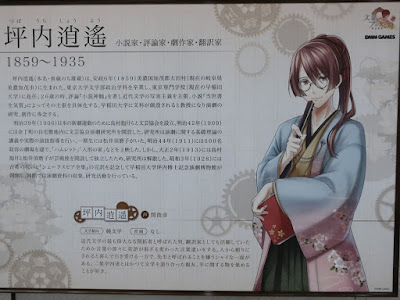Shinjuku is the busiest area in Tokyo now, but it was in the suburb and it was also the first post town from Edo (old name of Tokyo) on the kaidou (highway) in the Edo period (1603~1868). The transition of Shinjuku is shown in this museum.
I was surprised because there were nice resorts in Ochiai (it is in a city area now) and so on around two hundred years ago.
After the Edo period, urbanization made Shinjuku more and more energetic. Huge number of cafes, cabarets and theaters were opened. Many Japanese worked long hours and enjoyed nightlife at the same time.
I picked up interesting exhibits from each exhibition area. By the way, we are allowed to take photos of limited exhibits only.
新宿は、お江戸・日本橋から一つ目の宿場で、遊び場としても栄えた。宿場町の時代から、昭和以降、盛り場として発展するまでが展示されている。家康入国前の展示は少ない。
落合などが、江戸時代は風流な遊び場所だったのでびっくり。
一方、昭和になってから大発展で、映画、カフェ、キャバレーなどが増えていった写真や模型を見ると、風流を忘れて、日本のエネルギーを感じる。みんな、頑張っていたし、楽しんでいた、という感じだ。
各々の主題を持つ展示コーナーから、面白かった展示品をご紹介。写真撮影は、一部の展示品のみ可能。
Elegant entertainment (Furyu)、風流の世界のコーナー
Writers and artists visited Tamagawa in spring to see sakura cherry blossoms, Ochiai in summer to see fireflies, Omokage-bridge in winter to see the snow scene.
The beautiful
forests and rivers specially attracted people to Ochiai, so it was a theme of poems and pictures. The
drawing in which several chic people bring a sake bottle and walk into the
forest is exhibited with a Chinese style poem.
Edo-meisho (tourist spot)-zue (pictures) (1834, 1836) is exhibited.
Three men sat on the river side and drank, they watched the rapid stream in where a large rock made the water white. It's a fun time.
Three men sat on the river side and drank, they watched the rapid stream in where a large rock made the water white. It's a fun time.
Watching fireflies in Ochiai; we call the activity “Hotaru(firefly)-gari(hunting)”
Enlarged picture of above one、上の絵の拡大版
Reference: Ochiai firefly depicted in
Ukiyoe printing.
落合ほたる(豊国,広重 元治1年)
文人墨客は、春は玉川堤の桜、夏は落合の蛍、秋は落合の月、冬は面影橋の雪景色を楽しんだそうだ。特に、落合は、森や川の自然美が文人墨客を魅了し、詩や絵画に取り上げられた。五六人の粋人たちが酒樽をもって森に入る絵と漢詩が展示されていた。
江戸名所図会(1834年、1836年)の載っている、落合の一枚岩の横で酒を飲む絵、落合で蛍を見る絵が展示されている。楽しそうですねえ。
国会図書館が公開している同じ絵をアップします。おまけで、蛍狩りの錦絵も貼り付けておきました。
国会図書館が公開している同じ絵をアップします。おまけで、蛍狩りの錦絵も貼り付けておきました。
By the way, many authors lived in Shinjuku.
Harumachi Koikawa wrote funny books called “Ki (yellow)-byoushi (cover)”. The book below was published in 1775 in which the hero enjoyed a party in his dream. He was a samurai, though he had funny nick names.
“Kinbe’s
fantastic dream” @ Edo-Tokyo Museum 江戸博
江戸時代も、新宿には文人が多かった。
1775年に出版された洒落や滑稽を盛り込んだ庶民向けの黄表紙、「金々先生栄花夢」を書いた恋川春町。武士で、倉橋格(かく)という名だったが、酒上不埒(さけのうえのふらち)という名も名乗っていた。上の写真は、金兵衛が、按摩を受けながら宴会を楽しんでいるところだ。夢の中だけど。
狂歌作者が多く、面白いペンネームが多い。南総里見八犬伝の曲亭馬琴もいた。1775年に出版された洒落や滑稽を盛り込んだ庶民向けの黄表紙、「金々先生栄花夢」を書いた恋川春町。武士で、倉橋格(かく)という名だったが、酒上不埒(さけのうえのふらち)という名も名乗っていた。上の写真は、金兵衛が、按摩を受けながら宴会を楽しんでいるところだ。夢の中だけど。
In the Meiji period (1868-1912), modern authors (S. Tsubouchi, S. Natsume and so on) lived in Shinjuki. Yakumo Koizumi (Patrick Lafcadio Hearn), who was born in Greece and wrote Japanese themed fictions in English, also lived in Shinjuku.
They became animation characters nowadays. I will show them later.
明治になると、近代小説の坪内逍遥、夏目漱石を始め多くの人が新宿に住む。小泉八雲も住んでいた。今や彼らはDMMのゲームになって、アニメキャラになっている。
Since the Meiji period, theater plays have flourished in Shinjuku. Moulin Rouge was popular for its smart, refined and ironic play which was different from a traditional comedy in Asakusa.
In the Showa period (1926-1989), many intellectual people and university students started living here, so many cafes and bars opened. Plus, movie theaters and dancehalls also opened, so Shinjuku became the largest entertainment district in Japan.
GODZILLA on the building of Kabuki-cho
歌舞伎町のゴジラ
明治以降、芸術座など演劇でも発展していく。ムーランルージュは、浅草のドタバタ喜劇と違う、軽妙洒脱な風刺的作品で人気だった。
昭和に入るとインテリと学生の街、盛り場として発展する。更に、映画(キネマ)、ダンスホール、カフェーと日本一の歓楽街になった。
Shinjuku as a post town、宿場町・新宿
The model of the town in the Edo period. The daimyo lord Naito clan had their mansion here. Its garden became “Shinjuku Gyoen” park now.
内藤新宿の模型。内藤家の屋敷が大きい。甲州街道、江戸から一つ目の宿場として栄える。青梅街道との追分でもあった。内藤家の屋敷は巨大だ。庭園は、新宿御苑になっている。
Samurais、大名・旗本・御家人のコーナー
Naito clan donated belongings.There is a disguised sword which was used as a purse (keep money in it). It is 20cm long, and well-decorated by Japanese lacquer.
The towners used a portable sword with money for safety reason while
traveling. BUT, why did a strong samurai have this?
高遠藩主内藤家は譜代で三万石ぐらいだ。銭隠し道中差という内藤家寄贈の品があった。20cm弱で、茶色の鞘には上品な紅葉の柄が施してあるが、お金を入れたようだ。
町人が旅する時に、お金を隠しておくために持っていたものだが、大名には不要なはず。これを持っているのが面白い。
Town system、町の仕組みとしきたりのコーナー
With regard to demographics, people aged sixty-five and over accounted for 20%, so it was
already aging societies. Retirees always enjoyed life. I reckon they supported
writers and artists as students.
江戸時代の人口構成が今と似ていて、男女とも10歳と45歳ぐらいにピークがあって、30歳ぐらいが少ない。男が多いが、65歳以上も20%ぐらい居そうだ。ということは、隠居が多かったと言うことか。隠居は遊ぶ。文人達を支えていたのかも。
Miniature
articles and dolls excavated from kid’s tomb in the 19th century
attract me. Clay game pieces were so cute.
I can imagine how sad parents were.
このコーナーではないが、目を引いたのが、江戸後期(19世紀)の五歳ぐらいの子どもの墓から出土したというミニチュアの食器や人形。お皿が3cmぐらいだ。子どもが遊んでいて様子、悲しむ親が目に浮かぶ。泥面子(めんこ)という物も可愛らしい意匠であった。
Edo spirit and festivals、江戸のこころと祭りのコーナー
There
were many Fuji-kou which was a group who worshipped Mt. Fuji. Their
uniform to climb Mt. Fuji and an altar are exhibited.
In 1779,
Takada-fuji was built in Mizu-inari Shrine which became famous among the
people. Elder people, children and women who could not climb Mt. Fuji gathered.
It is a kind of an alternative Mr. Fuji. Afterward, many small Fuji were built
in various places.
Small Fuji “Fuji tsuka” near my house、流山市の富士塚
富士講の行衣と祭壇が展示されていた。富士講は江戸八百八講と言われるほど盛んだった。1779年、師を追慕するために築いた高田富士(水稲荷神社)が、江戸の名物となり、富士登山が出来ない老人、子ども、女人が集まったという。後に各地で富士塚が作られるきっかけになった。
江戸近郊の農村のコーナー
内藤新宿の外、淀橋(今の都庁辺り)は全くの農村だった。
Full-scale model of a kura (fire proof
storehouse) style candy shop、蔵造りのお菓子屋さんの実物大モデル
Adorable box、 小箱が可愛い
Animation and writers、アニメとのコラボ
Animation character of writers are created,
but those are much different from the actual ones. It’s a manga culture which entertains
readers.
作家がアニメキャラクターになっている。
S. Tsubouchi、坪内逍遙はこうなっていました
T. Shimazaki and K. Ozaki、島崎藤村と尾崎紅葉
Three funs(楽fun)were found. Visited in August, 2019
Website: https://www.regasu-shinjuku.or.jp/rekihaku/
(in Japanese)
accessed in May, 2020
Previous post (Entertainment regarding river around Tokyo):
Next post (War
museum in Shinjuku、英語名がすごい):















Comments
Post a Comment